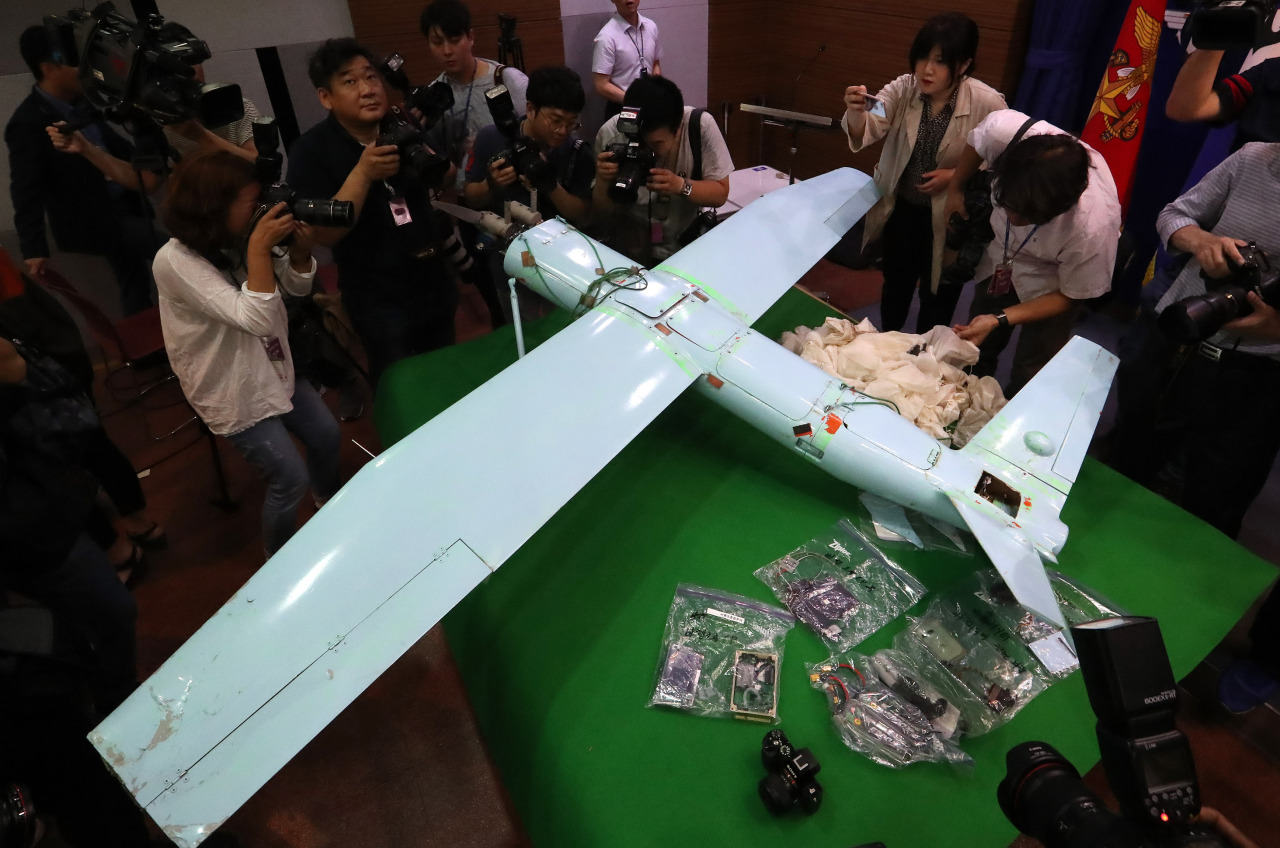N. Korean drones cross border
S. Korea struggles to shoot down NK drones that flew over Seoul, Gimpo, Paju and Incheon
By Ji Da-gyumPublished : Dec. 26, 2022 - 16:32

The South Korean military scrambled Air Force fighter jets and attack helicopters after first identifying an apparent uncrewed aerial vehicle that flew from North Korea and crossed south of the military demarcation line, the Joint Chiefs of Staff confirmed Monday afternoon.
One aircraft crashed in Hoengseong County, Gangwon Province, at 11:39 a.m. local time shortly after taking off from an air base in the city of Wonju, Gangwon Province, according to South Korea’s Air Force. The two pilots safely ejected from the aircraft.
In a tit-for-tat action, the military also mobilized and deployed crewed and uncrewed reconnaissance assets to the area in the vicinity of and north of the military demarcation line and conducted reconnaissance activities of filming the enemy’s key military facilities.
“Our military has taken countermeasures after detecting unidentified objects — presumed to be North Korean uncrewed aerial vehicles — starting from 10:25 a.m. local time on Monday in the areas of Gyeonggi Province,” the JCS said. “This is a flagrant violation of intruding our airspace.”
Four North Korean uncrewed aerial vehicles were spotted flying over the large Incheon island of Ganghwado, according to the JCS. One additional North Korean uncrewed aerial vehicle flew over Seoul, a military official who wished to remain anonymous confirmed.
The South Korean military fired several warning shots and issued warning communications to North Korea over the cross-border air offensive.
The military also fired around 100 shots from an attack helicopter toward one North Korean uncrewed aerial vehicle in the area nearby the island of Ganghwado.
But the South Korean military failed to shoot down the five North Korean aerial vehicles, the unnamed official said at 6 p.m., adding one was believed to return to North Korea.
Some North Korean uncrewed aerial vehicles flew over South Korean village areas and one vehicle was clearly visible to the naked eye, according to another unnamed military official.
The official added that their size was similar to the North Korean uncrewed aerial vehicles that were discovered in South Korean territory in 2014 and 2017. Their wingspan is estimated to be less than 2 meters, according to the JCS.
The first North Korean uncrewed aerial vehicle was spotted in the vicinity of Gimpo city but north of the military demarcation line.
In the aftermath of the airspace intrusion, the Seoul Regional Aviation Administration under the auspices of South Korea’s Ministry of Land, Infrastructure and Transport decided to temporarily suspend flights departing from Incheon Airport and Gimpo International Airport.
The last time the South Korean military publicly identified a North Korean drone trespassing into South Korean airspace was in June 2017.
At that time, the North Korean drone was found crashed in Inje County, Gangwon Province, with photos of the now-shuttered Lotte Skyhill golf course in Seongju County, North Gyeongsang Province, where the US-made Terminal High Altitude Area Defense anti-missile system has been deployed since that year.
North Korean uncrewed aerial vehicles also crossed the military demarcation line in 2015 and 2016 when inter-Korean tensions simmered.
In 2014, remains of North Korean drones were found in areas near the inter-Korean border, including Paju, Samcheok and the small island of Baengnyeong. Some North Korean drones had filmed the South Korean presidential office and military facilities.
“The intrusion of uncrewed aerial vehicles seems to be a continuation of North Korea’s recent provocations, including flying combat aircraft near tactical action line,” said Choi Hyun-ho, a military columnist at the JoongAng Ilbo. “North Korea intends to check the South Korean military’s readiness posture and use it as a justification for additional provocation in case of (counter) firing from the South Korean military.”
Yang Moo-jin, a professor at the University of North Korean Studies in Seoul, said North Korea has a track record of using uncrewed aerial vehicles mainly aimed for reconnaissance and intelligence-gathering.
“North Korea will seek to improve its reconnaissance capabilities by speeding up its development of military spy satellites. But before it achieves the goal, it will continue reconnaissance activities by utilizing uncrewed aerial vehicles,” Yang said. “But this is a clear violation of the Sept. 19 inter-Korean military deal that prohibits the activities of uncrewed aerial vehicles.”








![[Graphic News] More Koreans say they plan long-distance trips this year](http://res.heraldm.com/phpwas/restmb_idxmake.php?idx=644&simg=/content/image/2024/04/17/20240417050828_0.gif&u=)
![[KH Explains] Hyundai's full hybrid edge to pay off amid slow transition to pure EVs](http://res.heraldm.com/phpwas/restmb_idxmake.php?idx=644&simg=/content/image/2024/04/18/20240418050645_0.jpg&u=20240419100350)






![[From the Scene] Monks, Buddhists hail return of remains of Buddhas](http://res.heraldm.com/phpwas/restmb_idxmake.php?idx=652&simg=/content/image/2024/04/19/20240419050617_0.jpg&u=20240419175937)

![[KH Explains] Hyundai's full hybrid edge to pay off amid slow transition to pure EVs](http://res.heraldm.com/phpwas/restmb_idxmake.php?idx=652&simg=/content/image/2024/04/18/20240418050645_0.jpg&u=20240419100350)

![[Today’s K-pop] Illit drops debut single remix](http://res.heraldm.com/phpwas/restmb_idxmake.php?idx=642&simg=/content/image/2024/04/19/20240419050612_0.jpg&u=)